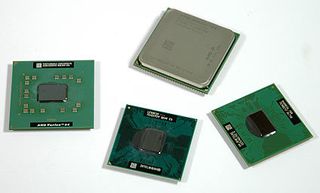Dual Core Processors For Low-Power, High-Performance Desktops
Can Core Duo Dominate Low-Power Systems?

More and more PC users run their systems 24 hours a day to permit functions such as downloading files, running backups, scanning for viruses and operating Web servers. PCs for these operations should be quiet and energy-efficient, while offering sufficient performance for the applications of both today and tomorrow. AMD's Turion 64 and Intel's Pentium M are the thriftiest processors when it comes to energy consumption, but, strictly speaking, both are becoming obsolete. The future belongs to dual core processors, as they provide substantial performance enhancements for a low-power PC.
If you look for a dual core processor, the obvious choices will be the AMD Athlon 64 X2 and the Intel Pentium D. We only recommend the 65 nm version of the Pentium D (the 900 series), because the aged 90 nm 800 series suffers from high thermal dissipation. Clearly, the Athlon 64 X2 offers superior performance and efficiency, but we are looking for high efficiency solutions, which draws our attention to Intel's latest mobile dual core processor: the Core Duo.
Intel's Core Duo is a 65 nm part and offers optimized performance per clock cycle thanks to its reconditioned microarchitecture, while drawing no more power than its predecessor, the Pentium M. Intel specifies a maximum design power of 31 W, which is an excellent result when put in the context of its performance. The Centrino Duo launch was spoiled by a USB power drain issue, which causes battery time to decrease dramatically. Since this proved to be a software issue, it is Microsoft courting our resentment now, as the promised patch has still not arrived. Luckily, this does not affect desktop applications, nor does it change our assessment of the Core Duo processor being one of the finest we have seen to date; it would be very appealing for a low-power PC.
The Core Duo uses the same processor socket as the Pentium M, but requires some electrical modifications, which means that you cannot use existing Socket 479 motherboards. Suitable products are not yet available, but several motherboard makers are working on them. We had a look at one of the first solutions back in March, AOpen's i975Xa-YDG 975X chipset is not known to be energy efficient. As there is currently no alternative, we decided to go for this motherboard and a Core Duo T2600 processor running at 2.16 GHz and FSB667.
AMD is getting ready to release the Turion 64 X2 dual core processor, but until this delicacy is served up, we will stick with the desktop dual core Athlon 64 X2 3800+ at 2.0 GHz and a Biostar TForce 6100-939 motherboard. Although the processor itself requires more energy than the Core Duo, the entire AMD64 platform is more energy efficient, so this promises to be a very interesting competition.
We also added a Pentium M 780 on a MSI 915GM Speedster and a Turion 64 MT-40 on a K8NGM-V to the lineup. Notice that these motherboards come with integrated graphics, but for the sake of a fair comparison with the AOpen i975Xa-YDG, we ran all systems with a dedicated graphics card.
Join our discussion on this topic
Stay on the Cutting Edge
Join the experts who read Tom's Hardware for the inside track on enthusiast PC tech news — and have for over 25 years. We'll send breaking news and in-depth reviews of CPUs, GPUs, AI, maker hardware and more straight to your inbox.
Current page: Can Core Duo Dominate Low-Power Systems?
Next Page Typical PC Energy Consumption ReviewedMost Popular

